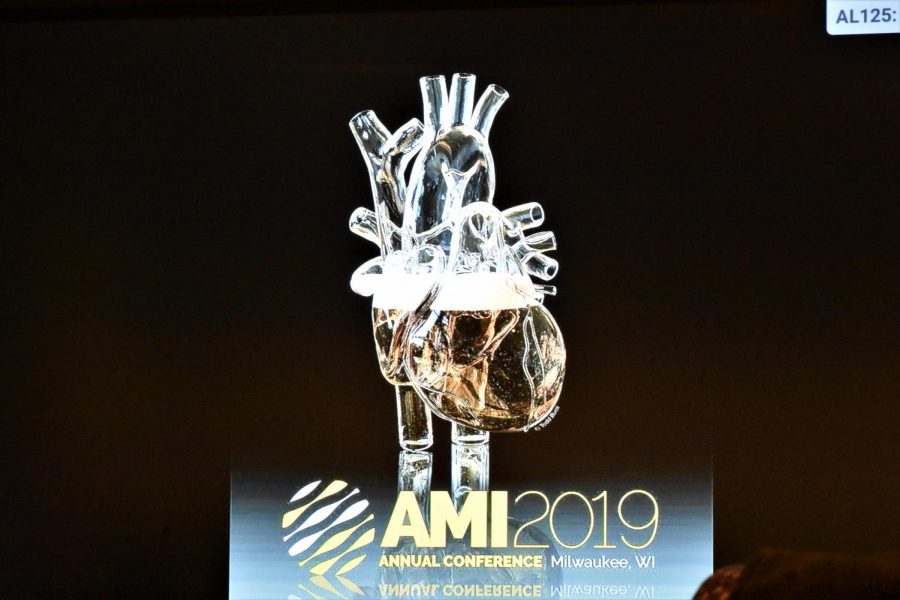Professor merges art, science
Jackson Gillette
Professor of illustration Todd Buck’s recent work “Beer Heart” combines art and science. The design was created using ZBrush, a digital sculpting tool that combines 3D and 2.5D modeling, and Keyshot, a 3D illumination program.
March 4, 2020
DeKALB — Uniting his passions for art and science, Todd Buck, professor of illustration at NIU’s School of Art and Design, has kept up a long career of providing medical illustrations for academic publications.
In a presentation 5 p.m. Tuesday at Altgeld Hall, Room 125, Buck demonstrated these passions by sharing examples of his art and discussing the history and current progress of his work in the profession.
Buck comes from a family of artists and had three high school instructors who were an influence on his chosen career path in creative writing, biology and art, he said. He began his higher education experience at Iowa State University simply as a biology major due to his uncertainty surrounding the benefits of having an art degree.
“Basically, I’m a result of [those three subjects]; I’m telling … scientific stories through visual artwork,” he said. “But I started in biology because I didn’t understand how you can make a living doing art.”
Buck said it wasn’t until someone caught a glimpse of the detailed drawings he did for a plant taxonomy class that it was recommended he apply for a degree program combining science and illustration.
“I met with the adviser who was heading up that program, and I changed my major that day; that was it,” he said. “And I’ve never looked back since.”
As an undergraduate student, Buck provided more than 60 illustrations of dissected animals for a zoology lab manual written by the chair of Iowa State University’s biology department. He shared two pages from the manual containing black-and-white illustrations he did highlighting the superficial muscles of a bullfrog.
“We got all these boxes of critters from the Carolina Biological Supply Company … and proceeded to dissect them, so I was basically drawing from observation every day of that summer,” he said. “That was good practice … of trying to capture something really exactly.”
Buck then moved on in 1988 to graduate school for biomedical visualization at the University of Illinois at Chicago. It was around this time that he learned about airbrush illustration, which he would go on to use in his own work.
“[The 1980s] was the decade of the airbrush,” he said. “I saw a work at one of the Association of Medical Illustrators conferences that was done with airbrush; I’m like, ‘Whoa, [I’ve] got to learn how to do that; that’s so cool.”
Buck presented some of his airbrush works during the presentation, including an illustration of the bioaccumulation of toxins in the Great Lakes and one of a close-up coronary-artery bypass surgery.
A year after graduation, Buck was able to land a job illustrating for a project authored by University of Chicago surgeon Christoph Broelsch titled the “Atlas of Liver Surgery.” He ended up having to produce 160 illustrations in a nine-month span.
“I worked all the time, but it was awesome because these were some of the first illustrations published of the living donor transplant procedure,” he said. “They actually took this left lobe of the liver and put it into a child. And it works.”
Buck said this project opened the gates to freelancing opportunities, and, as the years went on, he kept accumulating more and more clients. He proceeded to showcase another series of airbrush illustrations he did, including representations of wisdom tooth pain, fetal surgery and a staghorn kidney stone.
Over the years, Buck has continued to work more with digital animation, 3D techniques and Photoshop technology, he said. One of his more recent works is “Beer Heart,” which was done using ZBrush and Keyshot, digital sculpting and illumination programs, and debuted at the 2019 AMI conference in Milwaukee.
“This model is a ZBrush, [and] there’s three pieces of geometry,” he said. “There’s the heart, which I sculpted, and then I duplicated, shrunk and subtracted to make it hollow. There’s the liquid, and then there’s the foam.”
The foam was the most difficult part to get accurate, Buck said. So, to get it right, he resorted to using a more unorthodox method.
“I poured a beer,” he said. “With a little 3D tripod, I took a … bunch of [close-up] pictures of it and then, in Photoshop, applied it to just that layer on overlay. That’s the trick. All the reflections and everything stayed.”
Buck took questions from attendees after his presentation. During this portion, he informed the audience that there are about 9 available jobs as a 3D medical animator, and the placement rates for graduate students are at almost 100% due to the demand for those skills.
Correction: This story has been edited to correct that Todd Buck began his higher education experience at Iowa State University.
Correction: This story was edited March 9 to fix an error. Todd Buck said there were about 9 available jobs as 3D medical animator, not 9,000, as we originally wrote.







